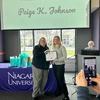Professor Jonathan Titus of the Fredonia Department of Biology and his wife, Priscilla, have discovered the non-native invasive insect, Hemlock Woolly Adelgid (HWA; Adelges tsugae) on 50 hemlock trees in the campus woodlot neighboring Ring Road.
It is the first known HWA infestation in Chautauqua County, according to Dr. Titus, the university’s Plant Ecologist.
The HWA, a native of East Asia, is less than 1.5mm in length, ranging in color from a reddish brown to black. It feeds on sap at the base of hemlock needles, causing needle loss and preventing trees from producing new buds. As the pest begins to mature, it leaves behind white cotton ovisacs that can produce as many as 300 eggs, usually the first sign of infestation. Once a tree is infested, its life expectancy is four to 10 years.
HWA has decimated all of the hemlocks throughout the southern Appalachians, dramatically transforming the landscape. Hemlocks make up about 10 percent of the trees in the campus woodlot.
It is unknown as to how the HWA was introduced to the area, but Titus says that humans with ornamental hemlocks and birds traveling from south to north are two common speculations.
“It is critical that the infestation in the college woodlot be controlled so that we can curtail spread and maintain our hemlock forests while scientists further develop effective bio control agents,” said Titus, who has been inspecting the campus woodlot for two years.
According to Titus, bio control would be the most effective treatment. “Beetle breeding,” a tactic through which a natural HWA predator is bred and introduced to the area, would likely stop the infestation. However, due to the lack of bio control agents in the region, injecting pesticides into the trunks of the hemlocks would be the other most potent approach.
Hemlock trees are beneficial to humans in producing pulpwood, building barns, sheds and other various structures.They are also a source of nourishment for many wild life animals. Rabbits, porcupines and red squirrels are a few of the many creatures dependent on the hemlock tree.
The College Lodge, home to some of the biggest and oldest hemlock trees in the region, has not yet been infested. However, Titus is also monitoring that acreage as well for early detection.
Fredonia’s Department of Biology is working with the New York State Department of Environmental Conservation to develop a control plan.



